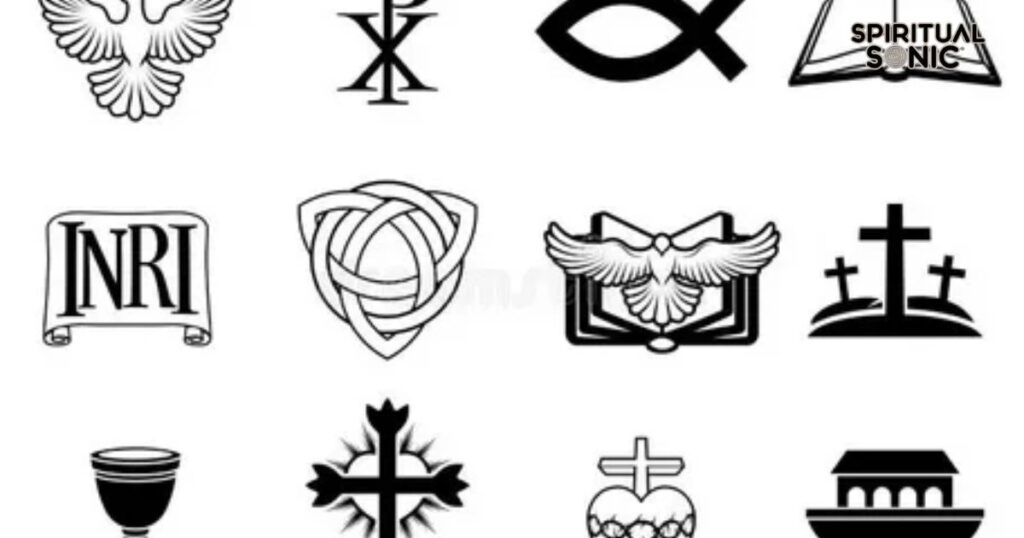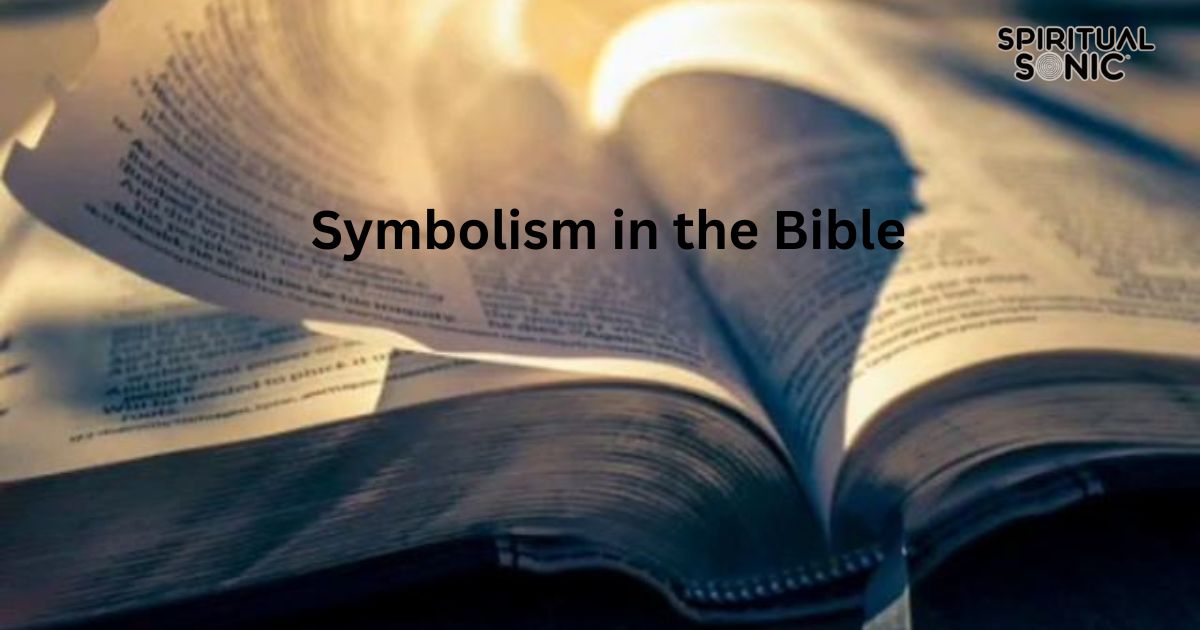Symbolism in the Bible is very important. It helps people understand God’s messages. Many things in the Bible have deeper meanings. Animals, numbers, colors, and objects all have symbols. These symbols teach lessons about faith, salvation, and God’s plan. For example, light represents truth, and water symbolizes cleansing. Mountains often mean God’s presence. Even common things like bread and wine hold spiritual meaning. Understanding symbolism in the Bible makes reading Scripture more meaningful and insightful.
Many stories use symbolism in the Bible to explain spiritual truths. The lamb represents Jesus as a sacrifice. The dove stands for peace and the Holy Spirit. Even places have meaning. For example, Zion symbolizes God’s kingdom. Colors like red and white represent sacrifice and purity. Numbers also hold significance, such as seven for completeness. Studying symbolism in Bible helps people see the deeper message behind every story. Each symbol points to wisdom and love.
What is biblical symbolism?
Symbolisms in the Bible is a way of using objects, numbers, and events to represent deeper spiritual meanings. Many biblical stories include symbols that convey God’s messages, helping believers understand faith, morality, and divine truths. For example, the lamb often represents Jesus as the sacrificial Savior, while water symbolizes purification and new life. These symbols add layers of meaning to scripture, making it more profound and relevant across generations.
Biblical symbolism also appears in numbers, such as seven, which represents completeness, and forty, which signifies a period of testing or transformation. Parables told by Jesus use everyday objects like seeds, bread, and light to explain spiritual lessons in a relatable way. By recognizing these symbols, readers can gain deeper insights into biblical teachings and apply them to their faith journey.
When is symbolism used in the Bible?
Symbolisms in the Bible appear throughout scripture, using objects, people, and events to convey deeper spiritual truths. It helps readers understand divine messages beyond literal meanings. For exam, in Genesis 1, you read that light represents God’s presence and truth, while darkness often symbolizes sin or separation from Him. These symbolic elements appear repeatedly, reinforcing key biblical themes.
Many parables and prophecies rely on symbolism to illustrate moral and spiritual lessons. Jesus frequently used it in His teachings, like when He called Himself the “Good Shepherd,” showing His guidance and care for believers. Sim, in Revelation, the Lamb represents Christ’s sacrifice, while the dragon signifies evil. Such imagery makes complex ideas easier to grasp, strengthening faith and understanding.
From the Old Testament to the New, symbolism in the Bible bridges the physical and spiritual worlds. It transforms ordinary things into powerful messages, making scripture timeless and relevant. Whether it’s a vine symbolizing growth in faith or fire representing God’s power, these symbols invite believers to reflect on their deeper meanings.
Related Post: Firmament Bible verse list: See the 30 key Verses
How to recognize when the Bible uses symbolism?
The Bible often uses symbolic language to convey deeper meanings beyond the literal text. Recognizing symbolisms in the Bible requires understanding historical context, cultural references, and recurring themes. For example, water frequently represents purification or new beginnings, as seen in baptism. Similarly, light often symbolizes truth and divine guidance, such as when Jesus is called the “light of the world.” Paying attention to repeated symbols and their meanings across different books helps interpret scripture more accurately.
Another way to identify symbolisms in the Bible is by looking at parables, visions, and metaphors used by prophets and Jesus. For instance, the mustard seed symbolizes faith, showing how something small can grow into great spiritual strength. Likewise, the lamb often represents sacrifice and redemption, as seen in references to Jesus as the “Lamb of God.” Understanding these symbols helps readers grasp the deeper spiritual messages behind biblical stories rather than just their surface meanings.
How to interpret Biblical symbolism?

Understanding symbolisms in the Bible requires looking beyond the surface of words to grasp deeper meanings. Many biblical symbols represent spiritual truths, moral lessons, or prophecies. For example, a dove often signifies peace and the Holy Spirit, while a lamb represents sacrifice and purity. Numbers also hold significance—seven symbolizes completeness, and forty often represents a period of testing. These symbols help readers connect with biblical teachings on a deeper level, making scripture more meaningful and applicable to daily life.
To interpret symbolisms in the Bible, consider the context and how similar symbols appear in different passages. A tree, for instance, can represent life, wisdom, or even a nation, depending on where it’s mentioned. Water may symbolize cleansing or renewal, while light often represents truth and guidance. Understanding these symbols requires studying biblical history, language, and cultural references. By recognizing recurring themes and their meanings, readers can uncover layers of wisdom hidden within scripture.
Difference between symbolism and typology
Symbolisms in the Bible uses objects, people, or events to represent deeper spiritual meanings. For example, a lamb often symbolizes Jesus and His sacrifice, while light represents truth and God’s presence. These symbols help convey complex spiritual messages in a way that is easy to understand. Symbolism is not tied to specific historical events but rather communicates timeless truths through metaphors and imagery.
Typology, on the other hand, is a method of interpretation where events or figures in the Old Testament foreshadow events in the New Testament. A well-known example is how Jonah’s three days in the belly of a fish prefigures Jesus’ three days in the tomb. Unlike general symbolisms in the Bible, typology relies on historical events as patterns or “types” that find their fulfillment later. Both approaches add depth to biblical interpretation, but typology connects past and future events directly.
Symbolism in the Bible’s allegories
Symbolisms in the Bible helps reveal deeper spiritual meanings through allegories and metaphors. Elements like fire, water, and mountains often carry symbolic significance. Fire can represent God’s presence or purification, while mountains symbolize divine revelation and strength. These symbols make complex teachings easier to understand and apply to daily life.
Many biblical allegories use symbolism to highlight faith, salvation, and moral lessons. They connect human experiences with divine messages, making spiritual truths more relatable. Through these symbolic stories, the Bible provides wisdom that remains relevant across generations.
Matthew 13:31-32
Jesus compares the Kingdom of Heaven to a mustard seed, emphasizing how something small can grow into something great. This allegory teaches that faith, even if tiny at first, has the potential to expand and bring immense spiritual growth.
How Jesus used symbolism
Jesus often used symbolism to teach profound spiritual truths in a simple, relatable way. His parables and metaphors connected everyday life to deeper lessons about faith, salvation, and God’s kingdom. Through these symbols, He made divine messages clear and memorable for His followers.
- Seed (Matthew 13:31-32)
- Vineyard (Matthew 20:1-16)
- Lamp (Matthew 5:14-16)
- Shepherd (Luke 15:4-7)
- Foundation (Matthew 7:24-27)
- Water (John 4:14)
- Gate (John 10:7)
- Rock (Matthew 16:18)
These symbols helped people understand God’s love, grace, and salvation. By using familiar imagery, Jesus ensured His teachings remained impactful and easy to remember, guiding believers toward a deeper relationship with Him.
More examples of symbolism in the Bible

The Bible is rich with symbolism, using objects, nature, and actions to convey spiritual truths. Examples include fire representing God’s presence, a lamb symbolizing Jesus’ sacrifice, and a crown signifying victory. These symbols deepen understanding, making complex teachings relatable and guiding believers toward faith, redemption, and divine wisdom.
Noah’s flood symbolizes baptism
Noah’s flood symbolizes baptism as both represent cleansing and a new beginning. Just as the flood washed away sin and brought renewal, baptism signifies spiritual rebirth and salvation. Water serves as a powerful symbol of purification, marking the transition from an old life of sin to a new life in faith.
1 Peter 3:20-21
During Noah’s time, while the ark was being prepared, only eight people were saved through water. This event serves as a symbol of baptism, which now brings salvation—not by simply washing away dirt from the body, but as a pledge of a faithful heart toward God, made possible through Jesus Christ’s resurrection.
The Tabernacle is a symbol of a heavenly tabernacle
The earthly Tabernacle was more than a sacred tent; it reflected the divine dwelling place of God. It symbolized the heavenly Tabernacle, where God’s presence resides. Every part of it, from the Ark to the veil, pointed to spiritual truths about worship, atonement, and God’s holiness.
Hebrews 8:5
The priests served in an earthly sanctuary that was only a shadow of the heavenly one. Moses was instructed to build everything according to the divine pattern, showing that the Tabernacle was a symbol of a greater, spiritual reality in heaven.
Waters symbolize nations
In the Bible, waters often represent nations, peoples, and multitudes. Just as the sea is vast and constantly shifting, nations rise and fall over time. This imagery is used in prophetic passages to describe the movement of kingdoms and the influence of global events on history.
Revelation 17:15
The angel explained that the waters seen in the vision represented many peoples, nations, and languages. This shows how the Bible uses water as a symbol of vast groups of people, illustrating the changing nature of worldly powers.
Stars have multiple meanings
Stars are frequently used in the Bible to symbolize different things, including angels, leaders, and divine guidance. They can represent God’s messengers, prophetic signs, or the faithful shining in righteousness. Their brilliance in the night sky often reflects guidance and God’s promises.
Daniel 12:3
Those who lead many to righteousness will shine like stars forever. This passage compares the faithful to stars, emphasizing their lasting influence and the glory that awaits them in God’s kingdom.
Trees symbolize believers
Trees in the Bible often represent people, particularly those who are rooted in faith. Just as a tree grows strong with deep roots, believers who stay connected to God bear spiritual fruit. This imagery highlights stability, growth, and spiritual nourishment.
Psalm 1:3
The righteous are like a tree planted by streams of water, yielding fruit in season. This verse illustrates how those who follow God flourish, just as a well-nourished tree remains strong and fruitful over time.
Mountains symbolize God’s dwelling place
Mountains in the Bible often represent God’s dwelling place, showing His power, majesty, and presence. Many significant events happened on mountains, where God revealed Himself to His people. Their towering heights symbolize His greatness, reminding believers that He reigns above all and is always in control.
Throughout Scripture, mountains serve as places of divine encounters. Moses met God on Mount Sinai, where he received the Ten Commandments. Jesus also revealed His glory on a mountain during the Transfiguration. These moments highlight how mountains are seen as sacred spaces where heaven and earth connect.
Mountains also symbolize strength and stability in faith. Just as mountains stand firm against storms, believers are called to trust in God’s unshakable power. They remind us that God is always present, offering guidance and protection, no matter how challenging life may be.
Object symbolism in the Bible
- The dove represents the Holy Spirit’s presence and peace (Matthew 3:16).
- The rock symbolizes God’s unshakable strength and protection (Psalm 18:2).
- The crown signifies victory, honor, and the promise of eternal life (James 1:12).
- The bread represents Jesus as the source of spiritual nourishment and life (John 6:35).
- The sword symbolizes God’s Word, truth, and spiritual warfare (Ephesians 6:17).
- The olive tree represents peace, divine blessings, and God’s covenant (Romans 11:17).
- The clay signifies humanity, molded and shaped by God’s hands (Isaiah 64:8).
- The lion represents Jesus as the powerful King and protector of His people (Revelation 5:5).
Animal symbolism in the Bible
- The lamb represents Jesus as the perfect sacrifice for sins (John 1:29).
- The serpent symbolizes deception and sin (Genesis 3:1).
- The eagle represents strength and renewal through God (Isaiah 40:31).
- The lion symbolizes Jesus’ power and kingship (Revelation 5:5).
- The dove represents the Holy Spirit and peace (Matthew 3:16).
- The ox symbolizes strength, service, and sacrifice (Proverbs 14:4).
- The wolf represents danger and false prophets (Matthew 7:15).
- The fish symbolizes faith and followers of Christ (Matthew 4:19).
More examples of Biblical symbolism
The Bible is filled with rich symbolism, where various elements, actions, and numbers hold deeper spiritual meanings. Every detail, from colors to locations, carries a message that connects to God’s plan. Understanding these symbols helps uncover the deeper truths hidden within the scriptures, making the Bible even more meaningful.
- Concepts with symbolic meanings: Sin, redemption, grace, covenant.
- Natural elements: Wind, lightning, mountains, rivers.
- Sacred numbers: 3, 7, 12, 40, 144,000.
- Significant locations: Bethlehem, Golgotha, Jordan River, Mount Sinai.
- Precious materials: Gold, silver, pearls, frankincense, myrrh.
These symbols are not just random details but intentional messages woven into biblical narratives. By studying them, you gain a clearer understanding of God’s teachings, His promises, and how everything in creation points back to Him. Each symbol carries layers of meaning that deepen faith and reveal divine wisdom.
FAQ’s
What is symbolism in the Bible?
Symbolism in the Bible uses objects, numbers, and actions to represent spiritual truths, helping believers understand God’s message more deeply through meaningful imagery.
Why does the Bible use symbolism?
The Bible uses symbolism to teach complex spiritual lessons in simple ways, making it easier for people to remember and apply God’s teachings.
What are common symbols in symbolism in the Bible?
Common biblical symbols include water for purification, fire for judgment, a lamb for Jesus, and light for God’s presence and truth
Why does the Bible use symbolism in the Bible?
The Bible uses symbolism to teach complex spiritual lessons in simple ways, making it easier for people to remember and apply God’s teachings.
Do biblical symbols have the same meaning everywhere in symbolism in the Bible?
Most biblical symbols hold consistent meanings, but context matters. Some symbols change meaning depending on the story or passage where they appear.
Conclusion
Biblical symbolism in the Bible is important in understanding God’s message. It helps explain spiritual truths in simple ways. Many things in the Bible have deeper meanings. Symbols like water, fire, and the lamb show God’s plan. Symbolisms in the Bible appears in stories, dreams, and teachings. It makes lessons clear and easy to remember. Many biblical symbols represent faith, judgment, and redemption. They give deeper insight into God’s will and promises.
Many symbols in symbolism in the Bible connect different events. They reveal God’s wisdom and purpose. Studying symbolisms in the Bible helps people grow spiritually. It shows how everything in scripture is connected. Many symbols represent love, sacrifice, and salvation. They guide believers in understanding God’s teachings. Learning about symbolisms in the Bible brings clarity to scripture. It helps people see God’s truth in every story.

Henry Davis – Content Writer
With three years of experience as a website content creator, I specialize in crafting engaging, SEO-friendly content that resonates with diverse audiences. My expertise spans various niches, ensuring high quality, well researched articles that enhance user engagement and drive organic traffic. Passionate about delivering value through words, I strive to create content that not only informs but also inspires action.

